AMD Ryzen 5 3600 Review: Why Is This Amazon's Best Selling CPU?
by Dr. Ian Cutress on May 18, 2020 9:00 AM ESTCPU Performance: Encoding Tests
With the rise of streaming, vlogs, and video content as a whole, encoding and transcoding tests are becoming ever more important. Not only are more home users and gamers needing to convert video files into something more manageable, for streaming or archival purposes, but the servers that manage the output also manage around data and log files with compression and decompression. Our encoding tasks are focused around these important scenarios, with input from the community for the best implementation of real-world testing.
All of our benchmark results can also be found in our benchmark engine, Bench.
Handbrake 1.1.0: Streaming and Archival Video Transcoding
A popular open source tool, Handbrake is the anything-to-anything video conversion software that a number of people use as a reference point. The danger is always on version numbers and optimization, for example the latest versions of the software can take advantage of AVX-512 and OpenCL to accelerate certain types of transcoding and algorithms. The version we use here is a pure CPU play, with common transcoding variations.
We have split Handbrake up into several tests, using a Logitech C920 1080p60 native webcam recording (essentially a streamer recording), and convert them into two types of streaming formats and one for archival. The output settings used are:
- 720p60 at 6000 kbps constant bit rate, fast setting, high profile
- 1080p60 at 3500 kbps constant bit rate, faster setting, main profile
- 1080p60 HEVC at 3500 kbps variable bit rate, fast setting, main profile
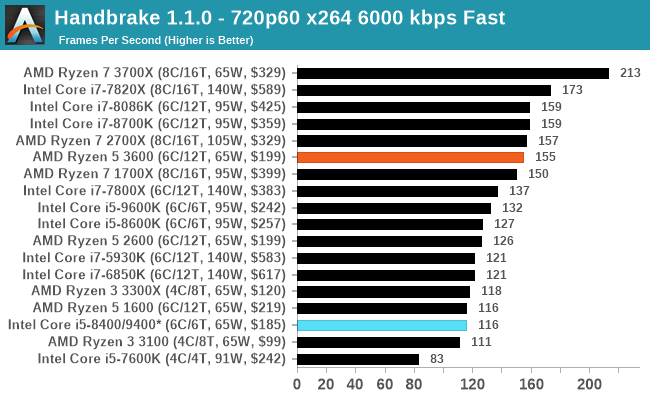
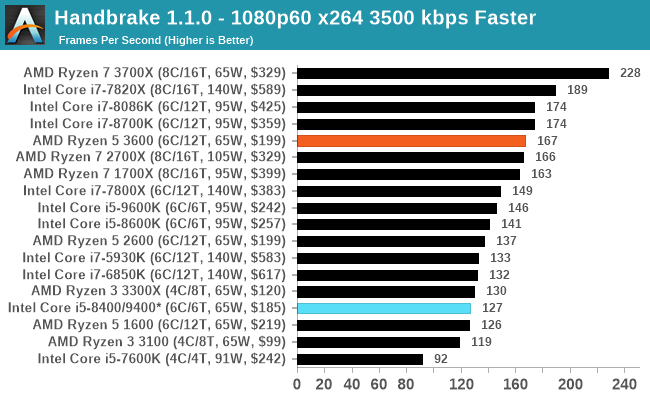

7-zip v1805: Popular Open-Source Encoding Engine
Out of our compression/decompression tool tests, 7-zip is the most requested and comes with a built-in benchmark. For our test suite, we’ve pulled the latest version of the software and we run the benchmark from the command line, reporting the compression, decompression, and a combined score.
It is noted in this benchmark that the latest multi-die processors have very bi-modal performance between compression and decompression, performing well in one and badly in the other. There are also discussions around how the Windows Scheduler is implementing every thread. As we get more results, it will be interesting to see how this plays out.
Please note, if you plan to share out the Compression graph, please include the Decompression one. Otherwise you’re only presenting half a picture.
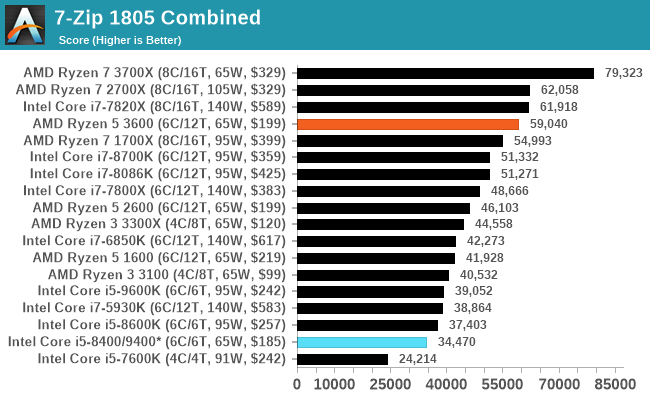
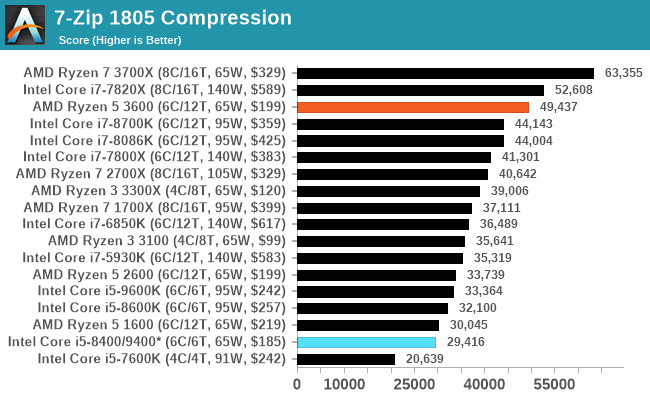
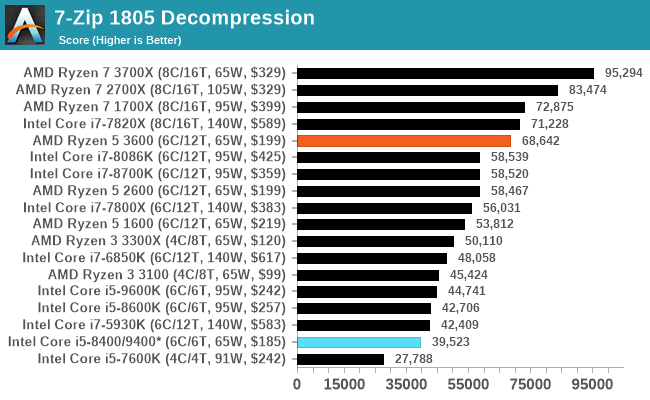
WinRAR 5.60b3: Archiving Tool
My compression tool of choice is often WinRAR, having been one of the first tools a number of my generation used over two decades ago. The interface has not changed much, although the integration with Windows right click commands is always a plus. It has no in-built test, so we run a compression over a set directory containing over thirty 60-second video files and 2000 small web-based files at a normal compression rate.
WinRAR is variable threaded but also susceptible to caching, so in our test we run it 10 times and take the average of the last five, leaving the test purely for raw CPU compute performance.
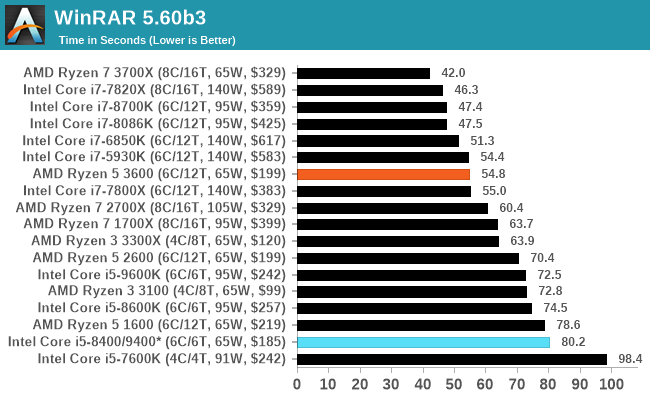
AES Encryption: File Security
A number of platforms, particularly mobile devices, are now offering encryption by default with file systems in order to protect the contents. Windows based devices have these options as well, often applied by BitLocker or third-party software. In our AES encryption test, we used the discontinued TrueCrypt for its built-in benchmark, which tests several encryption algorithms directly in memory.
The data we take for this test is the combined AES encrypt/decrypt performance, measured in gigabytes per second. The software does use AES commands for processors that offer hardware selection, however not AVX-512.
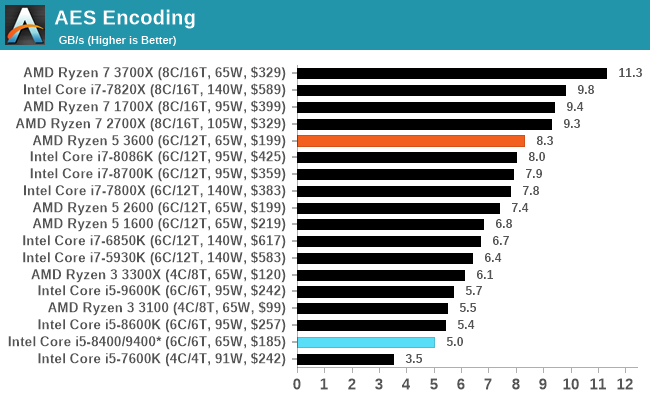










114 Comments
View All Comments
vortmax2 - Monday, May 18, 2020 - link
Anyone know why the 3300X is at the top of the Digicortex 1.20 bench?gouthamravee - Monday, May 18, 2020 - link
I'm guessing here, but the 3300X has all its cores on a single CCX and if Digicortex is one of those benches that's highly dependent on latency that could explain why the 3300X is at the top of the list here.I checked the previous 3300x article and it seems to be the same story there.
wolfesteinabhi - Monday, May 18, 2020 - link
Thanks for a great Article Ian and AT.the main problem with mid/lower range CPU (review) like this Ryzen 3600/X and even i5/i3's is that their reviews are almost always focused on "Gaming" (for some reason everything budget oriented is just gaming) ... no one talks about AI workloads or MATLABs, Tensorflows,etc many people and developers dont want to shell out monies for 2080Ti and Ryzen 9 3950X or even TR's .... they have to make do with lower end or say "reasonable" CPU's ... and products like these Ryzen 5 that makes sensible choice in this segment ... a developer/learner on budget.
a lot of people would appreciate if there are some more pages dedicated to such development workflows (AI,Tensor,compile, etc) even for such mid range CPU's.
DanNeely - Monday, May 18, 2020 - link
Ian periodically tweets requests for scriptable benchmarks for those categories and for anyone with connections at commercial vendors in those spaces who can provide evaluation licenses for commercial products. He's gotten minimal uptake on the former and doesn't have time to learn enough about $industry to create a reasonable benchmark from scratch using their FOSS tools. On the commercial side, the various engineering software companies don't care about reviews from sites like this one and their PR contacts can't/won't give out licenses.webdoctors - Monday, May 18, 2020 - link
Because office tasks don't require any computation, and gaming is what's most mainstream that actually requires computation.Scientific stuff like MATLAB, Folding@Home needs computation but if that's useful you'd just buy the higher end parts. Price diff between 3600x and 3700x (6 vs 8core) is $100, $200 vs $300 at retail prices. For someone working, $100 is nothing for improving your commercial or academic output. These are parts you use for 5+ years.
I agree a TR doesnt make sense if you can get the consumer version like a 3800x much cheaper.
Impetuous - Monday, May 18, 2020 - link
Logged in to second this. I think a lot of students and professionals like me who do research on-the-side (and are on pretty tight Grants/allowances) would appreciate a MATLAB benchmark. This looks like a great option for a grad student workstation!brucethemoose - Monday, May 18, 2020 - link
I think one MKL TF benchmark is enough, as you'd have to be crazy to buy a 3600 over a cheap GPU for AI training training. If money is that tight, you're probably not buying a new system and/or using Google Colab.+1 for more compilation benchmarking. I'd like a Python benchmark too, if theres any demand for such a thing.
PeachNCream - Monday, May 18, 2020 - link
A lot of people don't have money to throw away at hardware, moreso now than ever before so we are going to make older equipment work for longer or buy less compute at a lower price. It's important to get hardware out of its comfort zone because these general purpose processors will be used in all sorts of ways beyond a narrow set of games and unzipping a huge archive file. After all, if you want to play games, buying as much GPU as you can afford and then feeding it enough power solves the problem for the most part. That answer has been the case for years so we really don't need more text and time spent on telling us that. Say it once for each new generation and then get to reviewing hardware more relevant to how people actually use their computers.jabber - Tuesday, May 19, 2020 - link
Plus most of us don't upgrade hardware as much as we used to. back in the day (single core days) I was upgrading my CPU every 6-8 months. Each upgrade pushed the graphics from 28FPS to 32FPS to 36FPS which made a difference. Now with modest setups pushing past 60FPS...why bother. I upgrade my CPU every 6 years or so now.wolfesteinabhi - Tuesday, May 19, 2020 - link
as i said in one of the replies below... maybe TF is not a good example ..but its not like it will be purely on a CPU for TF work, but some benchmark around it ...and similar other work/development related tasks.Most of us have to depend on these gaming only benchmarks to guesstimate how good/bad a cpu will be for dev work. maybe a fewer core cpu might have been better with extra cache and extra clocks or vice versa ... but almost no reviews tell that kind of story for mid/low range CPU's.... having said that..i dont expect that kind of analysis from dual cores and such CPU ..but higherup there are a lot of CPU that can be made to do a lot of good job even beyond gaming (even if it needs to pair up with some GPU)